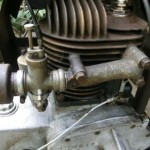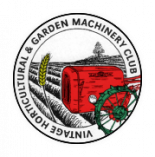Forum Replies Created
-
AuthorPosts
-
December 10, 2013 at 5:57 pm #3930
 wristpinParticipant
wristpinParticipantSame for both 75 and 98cc. Not sure that the Suffolk engine was original equipment on the Atco. Suffolk marketed several similar machines such as the Squire and Corporation.
December 10, 2013 at 10:52 am #3922 wristpinParticipant
wristpinParticipantYour image confirms it to be the Sidewwheel HD, later re-badged as the Toughcut. Pity about the well worn “slick” tyres which won’t have much grip!
Those wheels were mega expensive and are no longer available new.December 9, 2013 at 4:50 pm #3887 wristpinParticipant
wristpinParticipantI see no pictures!!
However there certainly was an Atco Toughcut which was around with various engines up until the early 70s I think. The chassis had many parts in common with the Atco SF34 and SF35 Mini gang mowers. Your version with the Villiers Lightweight was designated The Atco 20″ H.D. Sidewheel Motor Mower. Other variations were, the SF33 with a BSA/Villiers Sloper engine, SF13 with a Villiers Mk7 and the 24″ SH6 with a Villiers mk10. There may well have been others!!December 5, 2013 at 3:56 pm #3727 wristpinParticipant
wristpinParticipantPM sent
December 5, 2013 at 12:44 am #3723 wristpinParticipant
wristpinParticipantQuote “The great advantage of running shrinkpic is all you need to do is select the image and the rest is automatic, no messing about with opening another programme.”
Just tried to install Shrinkpic and Malwarebytes has quarantined it as a nasty!
December 3, 2013 at 4:43 pm #3644 wristpinParticipant
wristpinParticipantShrinkpic possibly makes it easier but the facility is there in Windows – just right click on your image wherever you store it. Then click on “edit” and you get the option to reduce to a percentage of the original or to a certain number of pixels.
For general posts of images to forums I usually go to 20 or 25% of the original. If you are likely to want an unreduced image in the future I suggest making a copy a copy of the original and doing your reduction on the copy as once you have reduced an image there is a loss of definition if you enlarge it.December 2, 2013 at 8:19 pm #3623 wristpinParticipant
wristpinParticipantWhat are we supposed to be looking at?!
December 1, 2013 at 10:29 pm #3593 wristpinParticipant
wristpinParticipantAs you say, a bit of a beast! Would think that it is more likely to be either 28″ or 34″ rather than 30. See that you have the “high cut” front castor wheels – seen plenty in parts books and catalogues but never seen a set fitted.
On the subject of that Atco Green paint code, did your supplier state what “paint system” that refers to such as RAL or Leicher?November 28, 2013 at 4:33 pm #3483 wristpinParticipant
wristpinParticipantI am fairly sure that I can remember Gravely with a Devon address being advertised in the UK publication Country Life. That would have been in the late 1940s, early 50s. Country Life is still going, – wonder how good their records/archives are?
November 26, 2013 at 7:05 pm #3433 wristpinParticipant
wristpinParticipantSome HT leads were screwed onto a spike in a recess cast into the coil and then sealed with some form of mastic/adhesive. Others were joined to the coil secondary winding before the coil “potting” material was cast around them. Problem is that unless you know you may **** a perfectly good coil in the process of finding out.
Unless you are looking for a cosmetically original/perfect result I’d slide a length of shrink insulation tubing over the existing lead.November 24, 2013 at 10:24 pm #3380 wristpinParticipant
wristpinParticipantFound an illustration of an “early 1920s” Edgecumbe and Rendle pusher with no seat. The mower is fitted with extended handlebars so that the operator could walk (run?) behind the whole assembly.
(page 25 of Old Lawnmowers by David G. Halford. Shire Publications ltd.)
November 24, 2013 at 9:09 pm #3374 wristpinParticipant
wristpinParticipantNo one has mentioned a date but I’m guessing that the development of these pushers may have been instigated by a shortage of labour as a result of The First World War. Estates and gardens that may have had plenty of cheap labour before the war may have had to mechanise to keep gardens and grounds maintained in the post war years.
November 24, 2013 at 7:38 pm #3364 wristpinParticipant
wristpinParticipantSeveral manufacturers made them to convert existing push mowers to powered ones.
November 17, 2013 at 7:58 pm #3160 wristpinParticipant
wristpinParticipantTotally agree with the last post – if the valves are not right you can fiddle (polite version) around with the ignition and carb till the cows come home and achieve little. I know that it requires a little more effort but it’s time well spent and if you know that they are right it is one thing that definitely definitely can’t be the cause of your problem.
Would you build a house without foundations?
I quote again – “Technicians who are valve critical will always have a better record of repair success than those who take a near enough approach”November 17, 2013 at 1:06 am #3114 wristpinParticipant
wristpinParticipantThe ammount of what looks like soft oily coke in the cylinder head suggest oil burning and ring wear but, if the engine is not going to be asked to work for its living, you may get away with giving as much attention to detail with compression and carburettion as you have to the ignition.
Fit a new needle and seat for the carb so as to hit that issue on the head for once and for all; although careful lapping may cure flooding, on a cost versus aggo basis I would go for new. (Meetens, Villiers Services or Villiers Parts).
As has been suggested, re-seat the valves. If either of the seats is badly enough pitted that the fine grinding paste will not restore it, it should be re-cut to maintain the correct angle and the valve re-faced. Prolonged lapping with coarse paste should be avoided as it tends to furrow the valve face and round the seat face.
My favourite quote from “Small Engine Secrets and Solutions” (unfortunately out of print) is
” Technicians who are valve critical will always have a better record of repair success than those who take a near enough approach”
Very true and a time saver in the long run. -
AuthorPosts
